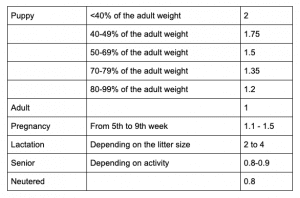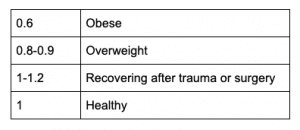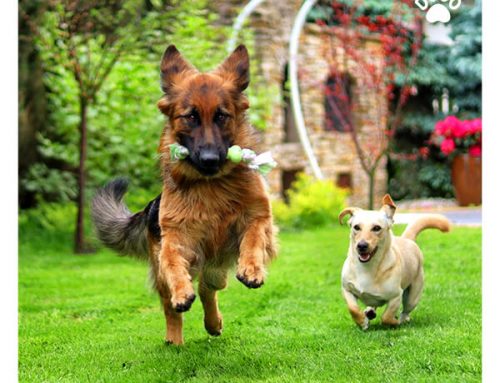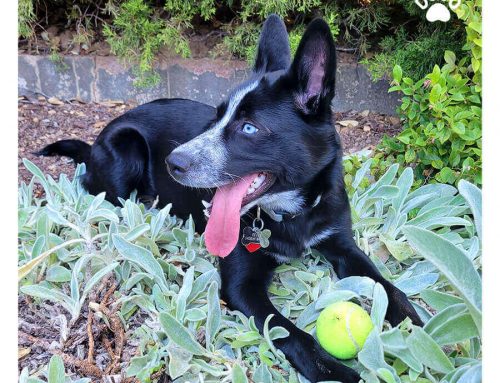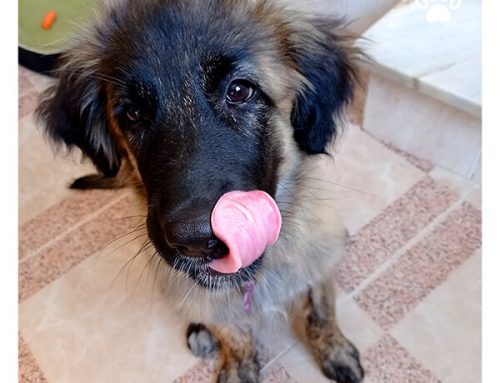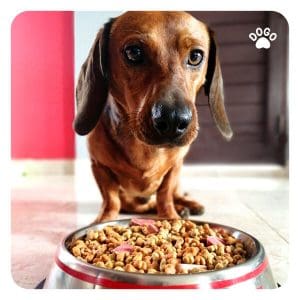
The formula:
Here is the formula that I used to calculate daily norms for my canine clients. Don’t be put off by it, we will explain in more detail how to use it.
Daily energy requirement DER=156 x Body Mass^0.67 x k1 x k2 x k3 x k4= … kcal
Body Mass – enter in kilograms
K1 – the dog’s breed
Different dog breeds get a different coefficient as the breeds differ in character and metabolic levels.
K2 – energy level
 K3 – physiology
K3 – physiology
K4 – a health condition
How to apply the formula?
Example No. 1
I have a Cocker Spaniel. She is a 3 month-old puppy, very active, weighs 6 kilograms, and has no medical conditions.
DER=156 x (Body Mass^0.67) x k1 x k2 x k3 x k4= … kcal
Body Mass – 6 kg
K1 – she is a Spaniel, so 0.9
K2 – she is very active and we spend more than 2 hours outside every day, on the weekends more, so 1.2
K3 – when she grows up, the expected weight is 12-15 kilograms, so she has reached let’s say between 40 and 49% of her adult weight, so 1.75
K4 – she has no conditions, so 1.
DER=156 x (6^0.67) x 0.9 x 1.2 x 1.75 x 1= 979 kcal
Example No. 2
I have a senior neutered Greyhound, who is turning 9 years old soon. He has arthrosis and is less active and mobile. He weighs 40 kg and his vet says that he should reduce the weight by 4-6 kilograms.
DER=156 x (Body Mass^0.67) x k1 x k2 x k3 x k4= … kcal
Body Mass 40
K1 – he is a sighthound, 1.1
K2 – he is very calm, so 0.8
K3 – he is an adult and neutered, 0.8
K4 – he has more than 10% more than his healthy weight, so he is obese – 0.6
DER=156 x (40^0.67) x 1.1 x 0.8 x 0.8 x 0.8= 1040kcal
Example No. 3
I have a Yorkshire Terrier, she is 12 months old and currently weighs 4.2 kilograms. She is healthy. We walk daily a few times per day but she doesn’t play with other dogs or runs much. I would describe her as ok active for a terrier.
DER=156 x (Body Mass^0.67) x k1 x k2 x k3 x k4= … kcal
Body Mass 4.4
K1 – she is a terrier, 1
K2 – her activity is average, so 1
K3 – she has reached her adult weight, so 1
K4 – she is healthy, so 1
DER=156 x (4.4^0.67) x 1 x 1 x 1 x 1= 421 kcal
Cooking at home
When cooking for your dog at home, it is important to ensure that they are getting a balanced diet that includes all the essential nutrients, including protein, fat, carbohydrates, vitamins, and minerals. You can find many recipes online that are specifically designed for dogs and take into account their nutritional needs. However, it is important to note that not all human food is safe for dogs to eat, and some foods can be toxic to them. For example, chocolate, grapes, and onions should never be given to dogs as they can cause serious health problems. Additionally, it is important to avoid feeding your dog table scraps or leftover food as it may not be nutritionally balanced and can cause digestive issues. If you are unsure about what to feed your dog, consult with a veterinarian or a canine nutritionist who can provide you with expert advice on how to create a healthy and balanced diet for your furry friend.
I know the calories – what now?
As you see the number of calories needed varies greatly dependng on the dog’s age, activity level, and medical conditions. If you are cooking at home, you can refer to the product calorie table, provided for humans. Keep in mind that dogs’ diet has to be mainly based on protein and fat and very little carbohydrates. If you are feeding a commercial diet, most food producers write on the package how many kcal there are in 100 gr. You can also check it here, a lot of known brands are listed on this page.
Create a Personalized Training Plan for your Dog


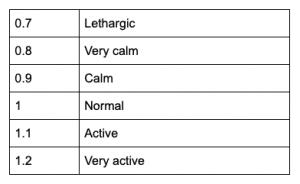 K3 – physiology
K3 – physiology